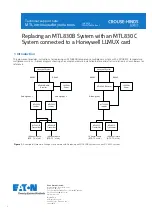
System Interconnects
Chapter 3: Installation
Page 3-22
VersaMux-4000 Operation & Installation Guide
Part No. 24001157
Revision C
NRZ DTE Operation
This section describes the function of the VersaMux-4000 control leads when the
NRZ interface is in the DTE mode (
Mode
parameter set to
DTE
).
DSR (DCE Ready)
When configured in the DTE mode, the DSR control lead is an input to the
VersaMux. The VersaMux ignores the state of this control lead.
DTR (DTE Ready)
When configured in the DTE mode, the DTR control lead is an output from the
VersaMux. The VersaMux asserts the DTR control lead at the beginning of the
activation sequence during power-up. It remains asserted during normal VersaMux
operation.
RTS (Request To Send)
When configured in the DTE mode, the RTS control lead is an output from the
VersaMux. The VersaMux de-asserts the RTS control lead at the beginning of the
activation sequence and asserts it at the end of the activation sequence. The
activation sequence typically takes several seconds to complete.
CTS (Clear To Send)
When configured in the DTE mode, the CTS control lead is an input to the
VersaMux. The VersaMux-4000 ignores the state of this control lead.
DCD (Received Line Signal Detector)
When configured in the DTE mode, the DCD control lead is an input to the
VersaMux. If the
Sync-Inhibit
parameter is
Disabled
, the VersaMux ignores the
DCD control lead. If the
Sync-Inhibit
parameter is
Enabled
, the Versamux
interprets the DCD control lead as follows:
During activation the VersaMux disables its multiplexing (mux) and
de-multiplexing (demux) functionality. When the VersaMux enables the demux
functionality, it ignores the DCD control lead for a minimum of one second to
allow the VersaMux demux to find frame. Once the VersaMux demux has
successfully found frame it will then monitor the DCD control lead. If the DCD
control lead is asserted, the VersaMux demux will operate normally (I.E. using its
normal criteria to determine/declare Loss-Of-Frame). If the DCD control lead is de-
asserted the VersaMux demux will ignore its normal criteria to determine/declare
Loss-Of-Frame, and continue to distribute data to the ports normally.
KG-Resync
When configured in the DTE mode, the KG-Resync control lead is an output from
the VersaMux. The VersaMux de-asserts the KG-Resync control lead at the
beginning of the activation sequence.
When the
KG-Resync
parameter is
Enabled
and the VersaMux de-multiplexer is in
the Loss-Of-Frame state for the period of time set by the
Resync-Delay
parameter
value, the VersaMux asserts the KG-Resync control lead for a period of 6-8
milliseconds (+/- 500 microseconds).
The VersaMux repeats this cycle of Resync-Delay followed by the KG-Resync pulse
for as long as the VersaMux de-multiplexer remains in the Loss-Of-Frame state.















































